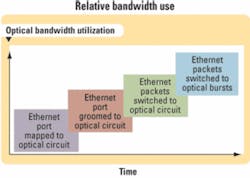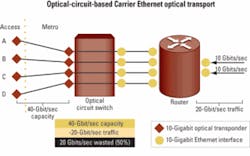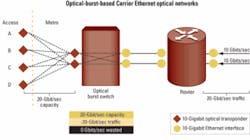by Mark Showalter
Investment in optical network systems is shifting from SONET/SDH to Ethernet over WDM. Ethernet over WDM is now the preferred approach for scaling transport networks for emerging applications such as Carrier Ethernet and triple play. To implement this approach, next-generation network planners can choose from among several technology options that combine the efficiencies of Ethernet switching with the enormous bandwidth of WDM optical transport technology.This article will review how optical technology has evolved to support Ethernet packet services, compare the bandwidth efficiency of the primary Ethernet over WDM optical transport technologies, outline the role of key emerging standards in Carrier Ethernet networks, and provide a framework to compare the capital and operational costs of Ethernet over WDM optical transport.
Developed in the early 1990s for carrier TDM networks and optimized for point-to-point traffic, SONET/SDH is the most widely deployed optical networking standard. Infonetics Research forecasts that investment in SONET/SDH optical networking equipment reached its peak in 2006, and that investment in optical networks is shifting from SONET/SDH to Ethernet over WDM.
Several factors combine to drive this shift. The meta trend is the dramatic increase in IP over Ethernet packet traffic relative to TDM traffic. SONET/SDH is optimized for point-to-point TDM and is inefficient for Ethernet aggregation. Another key factor is the advent of inexpensive 10-Gbit/sec Ethernet interfaces.Until recently, carriers had been willing to pay more for Ethernet-over-SONET/SDH equipment to get the benefits of a deterministic network, sub-50-msec recovery, and robust operations, administration, and maintenance (OA&M). As network traffic demands grew beyond SONET/SDH’s maximum capacity of OC-192 (10 Gbits/sec per ring), WDM optical circuit switches were introduced to allow stacking of multiple SONET/SDH rings on a single fiber. Stacked-ring architectures are expensive because of the number of non-revenue (non-customer facing) ports that must be deployed to transport packet service traffic.
The ITU-T Optical Transport Network (OTN) G.709 standard was developed early this decade to enable interoperability of optical multiplexers on point-to-point spans. OTN provides robust OA&M and forward error correction (FEC) along with support for Fibre Channel, ESCON, SONET/SDH, and Ethernet. Unfortunately, OTN is not optimized for Ethernet transport. The OTN-1 container is defined with a 2.5-Gbit/sec payload, so a Gigabit Ethernet port may be mapped to an OTN-1, but with a lot of waste.
Ethernet over WDM improves utilization of optical bandwidth for packet services by eliminating intermediate layers (SONET, OTN) for Ethernet transport. Most major telecommunication equipment providers have recently announced products to address this market. Ethernet over WDM combines the efficiencies of Layer 2 Ethernet switching with the enormous bandwidth of WDM while delivering deterministic packet services, sub-50-msec recovery, and robust OA&M.
Many existing and emerging standards focus on transforming Ethernet from an enterprise-class protocol to a carrier-grade service and transport engine.
The Institute of Electrical and Electronics Engineers’ (IEEE) 802.1q standard for local- and metropolitan-area networks was first published in 1998. IEEE 802.1q added virtual bridged LANs (VLANs) to the original Ethernet standard. VLANs enable traffic separation between multiple distinct Ethernet broadcast domains on a shared link. Also first published in 1998, the IEEE 802.1p standard for Ethernet class-of-service priority markings (IEEE 802.1p) enables relative prioritization of traffic flows across a link.The Internet Engineering Task Force’s (IETF’s) standard for multiprotocol label switching (MPLS) also provides traffic engineering tools, but enables only point-to-point connections for Ethernet services. The subsequent IETF standard for virtual private LAN services (VPLS) enabled MPLS networks to offer point-to-multipoint Ethernet services.
In 2004 the Metro Ethernet Forum (MEF) published technical specifications for carrier-grade Ethernet service definitions that bear considerable resemblance to the very successful Frame Relay service standards, albeit at much higher data rates than T1 or DS3.
The MEF’s Ethernet Private Line (EPL) service is defined as a point-to-point, private Ethernet circuit with a guaranteed data rate called committed information rate (CIR). EPLs are offered by many carriers today over existing SONET/SDH and OTN transport systems since they are essentially circuits, with no Ethernet aggregation, switching, or need for fine-grain quality-of-service control.
The MEF’s Ethernet LAN (E-LAN) service is defined as a point-to-multipoint Layer 2 Ethernet service. Market research firm Vertical Systems Group forecasts that E-LAN will be the fastest-growing Ethernet service as enterprise subscribers transition from Frame Relay to Carrier Ethernet services. A problem this creates for network operators is that E-LAN optical transport is expensive to implement with optical circuit technologies, since traffic for each E‑LAN access line must be backhauled to a Layer 2 switch for connectivity, which wastes capacity and increases costs.
E-LAN services are commonly used as the underlying infrastructure for higher layer services such as IPTV. In this case, however, the emulated broadcast domain is implemented over a series of point-to-point connections, which results in an inefficient solution.
Recent proposals from the ITU-T and IEEE take packet optical transport to the next level. Transport MPLS (T‑MPLS) is an emerging ITU standard specifically defined to provide transport-grade MPLS functionality, focusing on aspects such as OA&M and protection switching for the packet transport network.
Provider Backbone Bridges (PBB) and Provider Backbone Transport (PBT), also known as PBB-Traffic Engineering (PBB-TE), are emerging IEEE standards. With PBB, also known as MAC-in-MAC, the subscriber’s Ethernet MAC address and payload is encapsulated in an Ethernet frame and a provider (carrier)-based MAC address is used to switch across the carrier network.
PBT provides end-to-end Ethernet traffic engineering tools enabling the fine-grain quality of service required to efficiently transport a broad portfolio of Ethernet services with deterministic behavior across a common Carrier Ethernet optical transport network. The intention of PBB/PBT is to allow the use of lower-cost Layer 2 switching and Ethernet aggregation equipment to scale Ethernet transport networks for Carrier Ethernet services.
Ethernet-over-WDM technologies have steadily increased their relative utilization of optical bandwidth capacity. Figure 1 shows the relative bandwidth utilization of the primary Ethernet-over-WDM alternatives. Most currently deployed WDM platforms use optical circuit technology, where each wavelength is provisioned as a point-to-point optical circuit. To provision this point-to-point optical circuit, two optical transponders are dedicated to each optical link.
Early Ethernet-over-WDM systems mapped a single 1- or 10-Gbit/sec Ethernet port directly to a wavelength serving as an optical circuit for transport. Mapping a Gigabit Ethernet port into a 2.5- or 10-Gbit/sec wavelength is simple but wastes a lot of expensive optical capacity.
Figure 2 shows an optical circuit system that maps Ethernet ports to optical circuits. In this example, 20 Gbits/sec of traffic is coming from the core; the router delivers the traffic to the access nodes across the metro Carrier Ethernet optical transport network. The figure shows how optical circuits result in over-provisioning of capacity to transport the offered load. Since 2.5-Gbit/sec wavelengths will not be enough, 10-Gbit/sec wavelengths must be deployed, which results in idle capacity and increased costs.
To improve optical bandwidth utilization, optical circuit switch suppliers introduced Ethernet port-grooming modules that statically map multiple Ethernet ports to a single wavelength. For example, some systems can map multiple 1-Gbit/sec Ethernet ports onto a single 10-Gbit/sec wavelength. This slightly improves utilization of optical bandwidth-but every Ethernet port still burns a fixed amount of optical bandwidth whether or not there is any traffic on the port.
Recently, several suppliers have added Layer 2 packet switching modules to their optical-circuit platforms. These systems reduce the number of Ethernet ports required and improve optical circuit utilization by allowing any Ethernet packet from any Ethernet port to be switched to any of the preprovisioned wavelengths serving as optical circuits. This approach improves optical bandwidth utilization compared with packet-grooming systems, yet idle optical circuit bandwidth is still wasted.
Optical burst switching (OBS) has emerged as a practical alternative to optical circuit approaches. The primary difference between optical circuit systems and optical burst systems is that optical burst systems require about half as many transponders. Unlike optical circuit systems, which rely on a pair of dedicated transponders to communicate between only two points, optical burst systems rely on optical burst transponders that communicate with every node on the ring on a packet-by-packet basis. The use of such transponders brings packet multiplexing efficiency to the optical domain, where each transponder shares bandwidth across all nodes and idle capacity is reallocated in real time.
As with the other Ethernet-over-WDM approaches, OBS offers sub-50-msec recovery and provides deterministic, circuit-like transport of Ethernet packets. Figure 3 illustrates the relative bandwidth utilization of OBS.
Networking expenses traditionally are broken down into capital and operational expenses, and together they compose the total cost of ownership for Carrier Ethernet optical networks.
Capital expenditures for optical systems are primarily driven by the number of optical transponders that must be deployed, as these are the most expensive component of an optical network. Similarly, capital expenditures for packet systems are primarily driven by the number of high-speed Ethernet ports deployed. Network architects strive to minimize the number of transponders and non-revenue (non-customer facing) packet ports to minimize costs.
Ethernet-over-WDM systems that provide Ethernet port grooming and Layer 2 switching reduce the number of non-revenue Ethernet ports that face the router by increasing the connectivity within the optical circuit switch.
Ethernet-over-WDM optical-circuit-based platforms require two dedicated transponders for each point-to-point connection, whereas optical burst systems share transponder capacity across all nodes on the ring. As a result, OBS networks typically require about half the number of transponders and associated packet switch ports that an optical circuit architecture requires.
Carrier Ethernet optical network operational expenses arise from managing both the packet services infrastructure and the optical transport infrastructure. Within the optical transport infrastructure, operational expense is primarily driven by fixed operational costs in the form of service maintenance agreements. These service agreements are typically a percentage of the capital cost of the system. There are also variable operational costs resulting from forecasting, planning upgrades, provisioning new capacity, and re-engineering network capacity.
Network planners should consider both the mix of Ethernet services currently offered (most likely just EPL) and the inevitable request from marketing to offer additional E-LAN services from a common transport network. The more E-LAN services sold, the more complex the transport design becomes with optical circuit systems, as point-to-multipoint connections must be backhauled over optical circuits through non-revenue ports.
Ethernet over WDM is now the preferred approach for scaling transport networks for emerging applications such as Carrier Ethernet and triple play. Several alternatives are available with differing degrees of bandwidth utilization and cost structures. By combining the efficiency of Ethernet with the circuit-like controls of T-MPLS or PBT and the enormous bandwidth of WDM, Carrier Ethernet optical transport grows more affordable.
Mark Showalter is director, product marketing, at Matisse Networks (www.matissenetworks.com). With more than 20 years of experience in carrier data communications networking, he has helped drive the transformation of public networks from circuit based to packet based, with an emphasis on optical, IP, and Ethernet network technologies during his career at Pacific Bell, Ascend Communications, and other telecom equipment startups.


